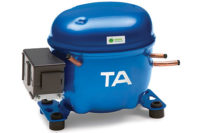In the first, ComStar International is providing test results of its blended hydrocarbon 188C2 versus HCFC-22 at a site in California. In the second, Midwest Refrigerants is reporting on its destruction technology getting “recommended for approval” status as part of a United Nations program.
COMSTAR
According to a document supplied toThe NEWSby ComStar, “Jerico Energy started up a 100-ton air conditioning unit at Cal Expo (in Sacramento, Calif.). This unit was equipped with kWh meters connected to an Internet data logger. The unit is factory charged with 129 lbs of R-22 refrigerant in each circuit.“After removing the factory charge, Jerico installed 32 lbs 4 oz. (25 percent of the factory charge amount) of HC188C2 hydrocarbon refrigerant. From the time the HC188C2 charge was completed, the system ran at near factory specifications on the HC circuit.
“The R-22 circuit operated normally. The air temperature differential at the evaporator while the R-22 circuit ran alone was 9 degrees F. While running only the HC188C2 circuit, the temperature differential was 13 degrees, indicating a 4 degree improvement in temperature differential with HC refrigerant during the charge and subsequent run period the day of the initial conversion.
“As the system ran for several days, a good sampling of the energy use and performance was obtained. The charging process was conducted by a service technician to bring performance to its optimal level. A total of 38 percent of normal was finally concluded as the best HC charge for overall performance.
“The objective of the conversion was to examine the compatibility of HC with ‘as built’ R-22 systems as a replacement refrigerant, which was confirmed. The visible HC performance gain of 9 percent was achieved with the complete unit ‘as built.’ We also observed that an additional reduction in kWh of 38 percent using HC with the engineering strategy and hardware changes employed successfully by Jerico on multiple commercial projects over the past four years. This would require some hardware changes not permitted as part of a compatibility test.”
MIDWEST
The Midwest Refrigerants announcement concerns a report from the United Nations Environmental Programme Technology and Economic Assessment Panel (UNEP-TEAP) which gave “recommended for approval” to the company’s destruction process that does not involve incinerating refrigerants. The recommendation means that Midwest’s approach can move toward final approval expected in November, according to Midwest president Lewis Steinberg.According to the UNEP-TEAP report, “This technology provides a novel approach to the destruction of ODS (ozone depleting substances) and involves the thermal reaction of ODS with hydrogen and carbon dioxide. The process results in an irreversible transformation and the performance criteria currently in place for ODS destruction are met, although there was initially some concern within the task force concerning the process flow adopted and the level of analytical verification. However, this has subsequently been resolved.
“Since the process is targeted to create hydrogen halides and/or halide salts as saleable bi-products of the destruction process, the normal screening criterion related to maximum HCl or HF levels in the stack gases does not really apply.
“The task force believes that this represents a significant additional technology option and, although it is still in its semi-commercial stage, recommends its inclusion in the Approved Technologies list.”
In all, four technologies, including that of Midwest, were recommended for approval; two others were said to show “high potential”; and one other was “unable to assess,” said the task force.
Publication date:08/01/2011







